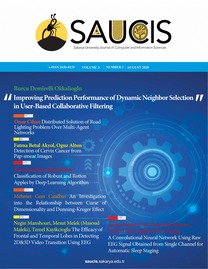An Analysis of the Characteristics of Verified Twitter Users
Doğrulanmış Twitter Hesaplarının Karakteristiklerinin Analizi
___
[1] “Q1 2019 Earnings Report,” Twitter, 2019. [Online]. Available: https://s22.q4cdn.com/826641620/files/doc_financials/2019/q1/Q1-2019-Slide- Presentation.pdf. [Accessed: 15-Nov-2019].[2] “Agency Playbook,” Twitter, 2019. [Online]. Available: https://cdn.cmstwdigitalassets. com/content/dam/businesstwitter/ resources/Twitter_Agency_Playbook_2019.pdf. [Accessed: 15-Nov-2019].
[3] “2018 Twitter Report,” Mention, 2018. [Online]. Available: https://info.mention.com/hubfs/Twitter Engagement Report 2018 %7C Mention.pdf. [Accessed: 15-Nov-2019].
[4] A. Pak and P. Paroubek, “Twitter as a Corpus for Sentiment Analysis and Opinion Mining,” in Proceedings of LREC’10, the Seventh International Conference on Language Resources and Evaluation, 2010, pp. 1320–1326.
[5] S. Waisbord and A. Amado, “Populist communication by digital means: presidential Twitter in Latin America,” Inf. Commun. Soc., vol. 20, no. 9, pp. 1330–1346, 2017.
[6] H. Kwak, C. Lee, H. Park, and S. Moon, “What is Twitter, a social network or a news media?,” in Proceedings of the 19th International Conference on World Wide Web (WWW ’10), 2010, pp. 591–600.
[7] R. Li, K. H. Lei, R. Khadiwala, and K. C. C. Chang, “TEDAS: A twitter-based event detection and analysis system,” in Proceedings of the 2012 IEEE 28th International Conference on Data Engineering, 2012, pp. 1273–1276.
[8] I. Paul, A. Khattar, P. Kumaraguru, M. Gupta, and S. Chopra, “Elites Tweet? Characterizing the Twitter Verified User Network,” in Proceedings of the 2019 IEEE 35th International Conference on Data Engineering Workshops (ICDEW), 2019.
[9] M. Hentschel, O. Alonso, S. Counts, and V. Kandylas, “Finding Users We Trust: Scaling Up Verified Twitter Users Using Their Communication Patterns,” in Proceedings of the 8th International AAAI Conference on Weblogs and Social Media (ICWSM 2014), 2014, pp. 591– 594.
[10] O. Varol, E. Ferrara, C. A. Davis, F. Menczer, and A. Flammini, “Online Human-Bot Interactions: Detection, Estimation, and Characterization,” in Proceedings of the 11th International Conference on Web and Social Media (ICWSM 2017), 2017.
[11] C. De Micheli and A. Stroppa, “Twitter and the underground market,” 2013. [Online]. Available: https://nexa.polito.it/nexacenterfiles/lunch-11-de_micheli-stroppa.pdf. [Accessed: 16-Nov- 2019].
[12] Y. Roth and D. Harvey, “How Twitter is fighting spam and malicious automation,” Twitter, 2018. [Online]. Available: https://blog.twitter.com/en_us/topics/company/2018/how-twitter-isfighting- spam-and-malicious-automation.html. [Accessed: 16-Nov-2019].
[13] H. L. LaMarre and Y. Suzuki-Lambrecht, “Tweeting democracy? Examining Twitter as an online public relations strategy for congressional campaigns’,” Public Relat. Rev., vol. 39, no. 4, pp. 360–368, 2013.
[14] Jason Baumgartner, “All Verified Twitter Users (100% complete) in ndjson format : datasets,” pushshift.io, 2018. [Online]. Available: https://www.reddit.com/r/datasets/comments/8s6nqz/all_verified_twitter_users_100_complete_ in_ndjson/. [Accessed: 15-Nov-2019].
[15] “API reference index — Twitter Developers,” Twitter, 2019. [Online]. Available: https://developer.twitter.com/en/docs/api-reference-index. [Accessed: 15-Nov-2019].
[16] B. Erşahin, Ö. Aktaş, D. Kilmç, and C. Akyol, “Twitter fake account detection,” in 2nd International Conference on Computer Science and Engineering (UBMK 2017), 2017, pp. 388– 392.
[17] “pandas: Python Data Analysis Library,” 2019. [Online]. Available: https://pandas.pydata.org. [Accessed: 16-Nov-2019].
[18] “Matplotlib: Python plotting — Matplotlib 3.1.1 documentation,” 2019. [Online]. Available: https://matplotlib.org. [Accessed: 16-Nov-2019].
[19] T. Velayutham and P. K. Tiwari, “Bot Identification: Helping Analysts for Right Data in Twitter,” in Proceedings - 2017 3rd International Conference on Advances in Computing, Communication and Automation (Fall) (ICACCA 2017), 2018, pp. 1–5.
[20] S. Yardi, D. Romero, G. Schoenebeck, and D. Boyd, “Detecting spam in a Twitter network,” First Monday, vol. 15, no. 1, 2010.
- ISSN: 2636-8129
- Yayın Aralığı: Yılda 3 Sayı
- Başlangıç: 2018
Hafif Sıklet Şifreleme Algoritmalarının Performans Karşılaştırması
Ünal ÇAVUŞOĞLU, Hussein AL SANABANI
An Analysis of the Characteristics of Verified Twitter Users
Abdullah Talha KABAKUS, MEHMET ŞİMŞEK
İbrahim CIL, Sümeyye Gizem ÇAKAR, Nazan SARI, Olcay EYDEMİR
Design Tradeoffs in Full Electric, Hybrid and Full Chemical Propulsion Communication Satellite
EOG İşaretini Kaynak İşaret Olarak Kullanmak Üzere Etkin Özelliklerin Belirlenmesi
